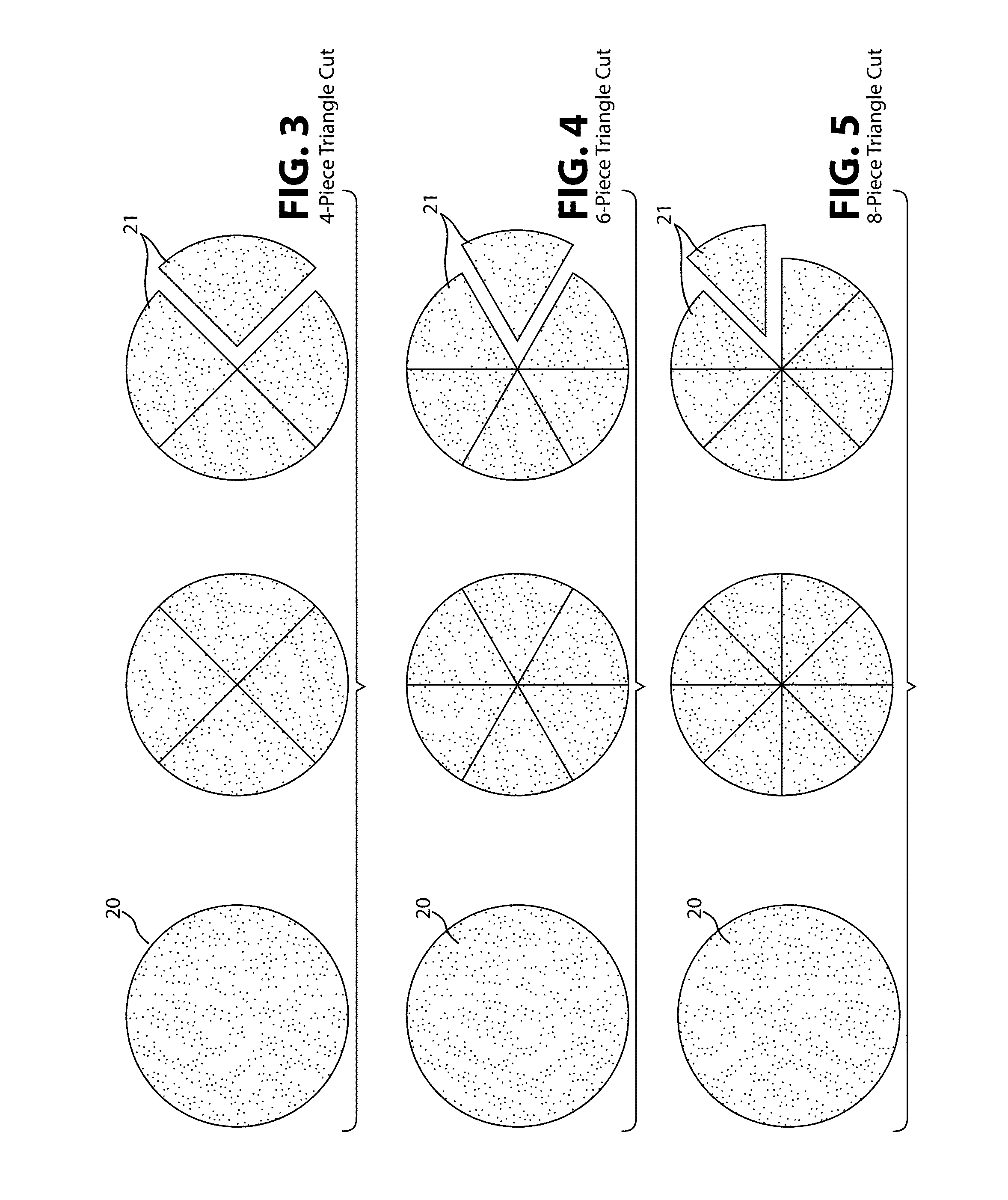Continuous Tortilla Chip Cutter
a technology of continuous cutting and tortilla chips, which is applied in the field of assembly line food production machinery, can solve the problems of substantially imperfect chips, difficult to get all of the cuts to go through a common center, and relatively laborious process
- Summary
- Abstract
- Description
- Claims
- Application Information
AI Technical Summary
Benefits of technology
Problems solved by technology
Method used
Image
Examples
first preferred embodiment
General Operation
[0069]There are many possible embodiments of a Continuous Tortilla Chip Cutting System according to the present invention. FIGS. 6 and 7, for example, are schematic top and side views of a first preferred, albeit simplified embodiment of a Continuous Tortilla Chip Cutting System 10 for cutting tortillas 20 into pre-cuts 21. As shown in FIGS. 1 and 2, the system 10 receives the tortillas 20 from an upstream flatbread production line 30 which may be fully automated, manual, or some combination thereof. As shown, the system 10 comprises a conveyor 40 that is driven by a conveyor motor M40, a detector 50, a cutting mechanism 60 that is driven by a cutter motor M60, and a controller 70.
[0070]The goal is to form pre-cuts 21 that are distinct from one another, undamaged, and of consistent shape. The pre-cuts 21 formed by the system 10 are usually intended for frying, after further cooling or at some time in the future. For example, the producer may sell the box 80 of pre-c...
second preferred embodiment
[0075]FIGS. 8 and 9 are schematic top and side views of a second preferred embodiment of a continuous flat bread cutting apparatus 210 that is similar to the first preferred apparatus 10, but more specifically comprises a cutting mechanism 260 that formed from a pair of counter-rotating rollers 262, 264. As suggested by FIG. 9, the preferred upper roller 262 has a substantially smooth surface for cutting against (made e.g. of UHMW polyethylene), and the lower roller 264 has a plurality of blades 265 that rotate against the upper roller 262 (made e.g. of stainless steel). The key to consistent operation is to have the cutter roller 264 in a known starting position prior to the detection of each subsequent flatbread unit 20, and then to start its rotation at just the right time to cut each flatbread units 20 into correctly shaped pre-cuts21.
[0076]FIG. 10 is a perspective view of the cutting mechanism 260 used in the second preferred embodiment of FIGS. 8 and 9. As shown, the upper rol...
third preferred embodiment
[0081]FIG. 13 is a perspective view of a third preferred embodiment that is like the second preferred embodiment, but comprises a suitable frame 320 that supports two parallel conveyor belts 40 and two corresponding cutting mechanisms 260 for providing increased throughput when fed by a two-row tortilla production line.
[0082]FIGS. 14 to 16 are top, input end, and output end views, respectively, of the third preferred embodiment of FIG. 13.
PUM
| Property | Measurement | Unit |
|---|---|---|
| shape | aaaaa | aaaaa |
| velocity | aaaaa | aaaaa |
| distance | aaaaa | aaaaa |
Abstract
Description
Claims
Application Information
 Login to View More
Login to View More - R&D
- Intellectual Property
- Life Sciences
- Materials
- Tech Scout
- Unparalleled Data Quality
- Higher Quality Content
- 60% Fewer Hallucinations
Browse by: Latest US Patents, China's latest patents, Technical Efficacy Thesaurus, Application Domain, Technology Topic, Popular Technical Reports.
© 2025 PatSnap. All rights reserved.Legal|Privacy policy|Modern Slavery Act Transparency Statement|Sitemap|About US| Contact US: help@patsnap.com



